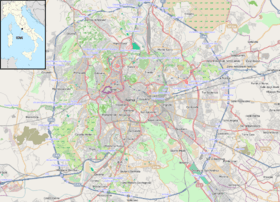MAXXI
MAXXI (Italian: Museo nazionale delle arti del XXI secolo, "national museum of 21st-century arts") is a national museum of contemporary art and architecture in the Flaminio neighborhood of Rome, Italy. The museum is managed by a foundation created by the Italian ministry of cultural heritage. The building was designed by Zaha Hadid, and won the Stirling Prize of the Royal Institute of British Architects in 2010.
 MAXXI exterior | |
 Location of the museum in Rome | |
| Established | 2010 |
|---|---|
| Location | Rome, Italy |
| Coordinates | 41.929°N 12.466°E |
| Architect | Zaha Hadid |
| Website | maxxi |
History
An international design competition for the design of the museum building was won by Zaha Hadid. Her submission included five separate structures, of which only one was completed. It was built on the site of a former military barracks, the Caserma Montello, incorporating parts of it.[1]
The museum took more than ten years to build, and opened to the public in 2010.[2][3] It received the Stirling Prize for architecture of the Royal Institute of British Architects in the same year.[4]
The Guardian has called the MAXXI building "Hadid's finest built work to date"[2] and "a masterpiece fit to sit alongside Rome's ancient wonders".[3]
Description

MAXXI consists of two museums: "MAXXI art" and "MAXXI architecture".[5] The outdoor courtyard surrounding the museum provides a venue for large-scale works of art.[6]
Collections
The permanent collections of these two museums grow through direct acquisitions, as well as through commissions, thematic competitions, awards for young artists, donations and permanent loans.
The collection includes works by Alighiero Boetti, Grazia Toderi, William Kentridge, Kara Walker, Ed Ruscha, Gilbert & George, Gino De Dominicis, Michael Raedecker, Anish Kapoor, Gerhard Richter, Francesco Clemente, Lara Favaretto, Marlene Dumas, Maurizio Cattelan, Gabriele Basilico, Kiki Smith, Thomas Ruff, Luigi Ghirri, Manfredi Beninati, Vanessa Beecroft, Stefano Arienti, Francis Alys, Ugo Rondinone, Thomas Schutte, Francesco Gostoli, and archives of architects Carlo Scarpa, Aldo Rossi and Pier Luigi Nervi.[3]
See also
References
| Wikimedia Commons has media related to MAXXI. |
- Riccardo Bianchini. "Zaha Hadid – The MAXXI Museum Rome – part 1". Inexhibit. Retrieved December 5, 2015.
- Jonathan Glancey: Zaha Hadid's stairway into the future, in The Guardian, 16 November 2009, retrieved 5 July 2010
- Rowan Moore: "Zaha Hadid's new Roman gallery joins the pantheon of the greats", in The Guardian, 6 June 2010, retrieved 5 July 2010
- Jonathan Glancey (4 October 2010). Zaha Hadid's Maxxi was the right choice for the Stirling prize. The Guardian. Accessed August 2018.
- Fondazionemaxxi, retrieved 5 July 2010
- Junkin, Caitlin. "At Maxxi in Rome, Urban Gardens Bloom," New York Times. September 16, 2011; excerpt, "Natural and recyclable materials like pressed hay, soil and grass were used in construction of the archipelago, rendering an organic touch to the museum’s concrete areas"; retrieved 2011-09-28.